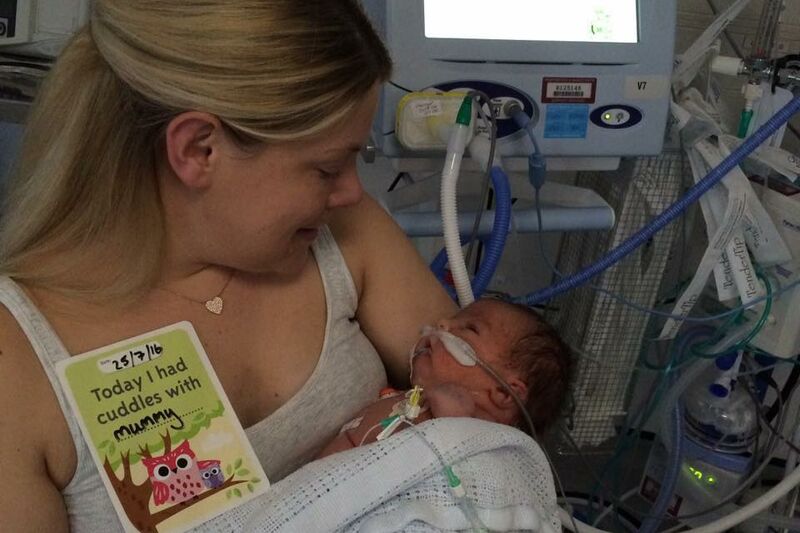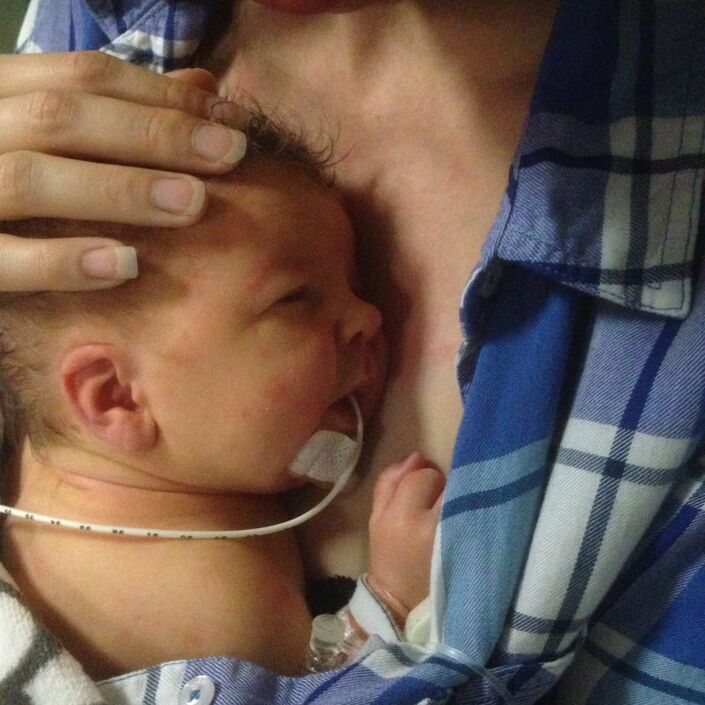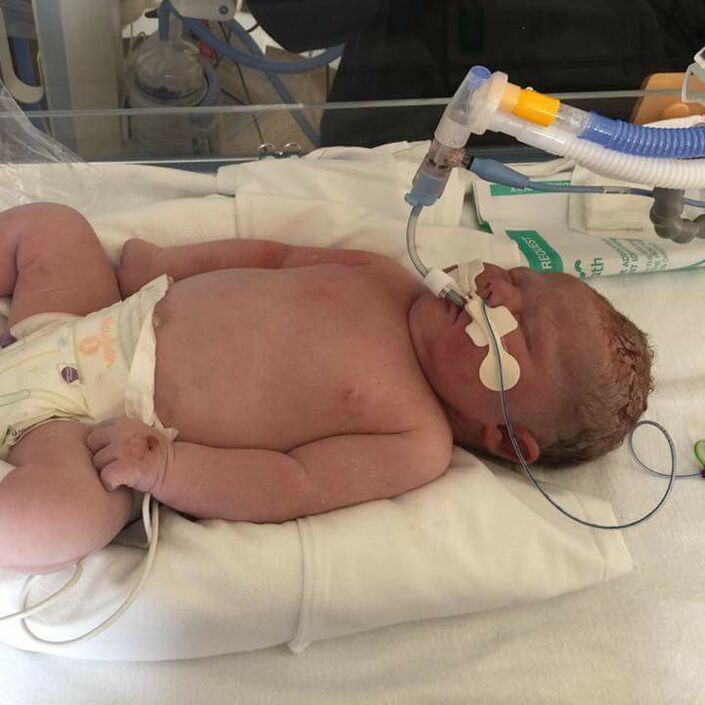
When I was almost 38 weeks pregnant, I woke up with the feeling that something wasn’t quite right. My baby had not kicked me through the night like he usually did and I was deeply worried about why he was being so quiet.
I attended the assessment unit and was whisked straight to theatre for an emergency c-section because the baby was in distress. They had minutes to perform the operation but the anaesthetic failed to work. Usually when this happens, the mother is put under but because I have a pre-existing heart condition they were unable to put me to sleep in case I went into cardiac arrest.
The surgeon called the team to a halt and told me that she had made a decision – if it came to it, she was going to save my life over the baby.
After 71 terrifying minutes, George was born weighing 7lb 8oz and was passed to my husband. After a few minutes he crashed in his arms and required extensive resuscitation. When he was stable, he was transferred to the neonatal intensive care unit (NICU) where he remained for 73 days.
I was kept in the delivery room due to a haemorrhaging vessel. I spent two days in recovery strapped to a heart monitor and emergency defibrillator before being well enough to see George for the first time.
Whilst I waited to meet George, I was told that he was in dire straits and had been placed on life support. My placenta had failed so oxygen and blood flow had been reduced. This caused George to become hypoxic and his blood had become acidic. The doctors were treating him for Hypoxic Ischemic Encephalopathy (HIE). He would be cooled for 72 hours and then warmed back up again. This process prevents and reverses damage caused to organs by lack of oxygen.
The first time I went to see George I was petrified. My husband wheeled me into a room where eight incubators with babies inside were attached to machines that beeped constantly and surrounded by medical teams.
I had no idea which baby was George until my husband pointed to cot number eight. At the time, 12 professionals were surrounding George performing a brain scan. The staff told me that they suspected he had a significant brain bleed and that a specialist was scheduled to see him later. I didn’t even get to see George because I was too upset and overwhelmed and my husband had to wheel me out of the unit. We searched desperately for a place where we could cry in private.

The following day the Consultant confirmed that the bleed on the brain was of no significance and we were hugely relieved. We still had to wait to find out whether the HIE treatment had worked and were warned that the results may mean that George may never be able to smile, walk, talk or do anything we would expect him to do.
George’s MRI scan was returned from London and miraculously it was confirmed that his brain activity was normal. The consultant said she was surprised to see how well he was doing after his rough start but she was extremely pleased with the progress he had made.
George and I were both diagnosed with sepsis. Once again, we were told to expect the worst. On day nine, I was finally allowed to hold George for the first time. I felt helpless and went through a grieving process which continues to this day. I was discharged after 15 days and going home without George was the hardest thing I ever had to do.

I longed to do normal things like sit on the sofa with him, take him out in a pram and wake up with him near me. The weeks after giving birth are meant to be a happy time in which you show off the new baby to your friends and family. Instead, I went home to an empty house without a visitor in sight other than my parents. I felt like the birth of my son was not celebrated, but I was also too scared to celebrate in case things got worse.
My husband went back to work and I was surrounded by an eerie silence where there should be the sound of a baby’s cry. I spent my days going to and from the hospital and endless hours watching my baby who was strapped to equipment that beeped continuously. The unit was very dark with no natural light and felt like a prison at times. The first time I showered at home, all I could hear was the sound of the beeps ringing in my ears.
George’s blood pressure dropped dangerously low and he required cardiovascular support as he went into heart failure. He had a grave autoimmune response and his body was struggling with deranged blood. He was severely anaemic with significantly low blood platelets. George had a total of 12 blood transfusions including platelets and suffered aggressive rashes.
George was seen by specialists from immunology, haematology, dermatology, cardiology, endocrinology and more. But no one could find the answer as to why our baby was so sick. It was decided that he required a Bone Marrow aspiration to see what was happening in the factory of where his blood cells were made. We were taken to a quiet room and talked through a bone marrow aspirate. The haematologist was honest. In her career she had done over 10,000 bone marrow aspirates but only five babies. She explained the bone marrow would be taken from his leg as opposed to his hip and something like leukaemia would be visible in the lab immediately. Fortunately, the test came back normal.
George became ‘Mystery George’ as consultants in our NICU and other NICUs scratched their heads as to why he was so ill. Every day we celebrated no diagnosis, but then prepared ourselves for a potential new one. I gave countless samples of blood, CT scans and more. My husband also gave blood so it could be mixed with my blood in a lab in Bristol to see whether my antibodies attacked his blood cells.
George underwent three lumbar punctures, over 150 blood tests and was treated for suspected meningitis on three occasions. We sat patiently and waited for him. George went on to suffer some complications from the HIE cooling process including a rare skin condition called subcutaneous fat necrosis resulting in hypercalcemia - dangerous levels of calcium in the blood. At this point a Professor came to discuss using a drug for this with us as the consultants had not used the drug in the NICU before. We agreed but the drug worked too well resulting in George requiring calcium infusions. We went from one extreme to another.
By miracle we left the unit on the 27 September 2016 and walked away with no significant diagnosis just ‘Mystery George’. It felt surreal. We searched for hope during our stay but George’s journey was so unique we didn’t feel like we could find any.

With no diagnosis or explanation of why George was sick we found it hard for people to relate to our story, but we did make great friends on the unit. I guess sometimes you don’t get answers. George was still considerably poorly when he came home and we required outreach care for weekly blood tests for around six months.
He is now 19 months old and extremely well. He has hit all of his milestones and has surpassed expectations. During our darkest days we never thought this would happen. Our time in NICU has changed us. I will never be the same person as I was before the night George stopped kicking. It’s been a long journey, one which we are still on. You focus so much on getting out of the NICU you do not realise the post NICU journey is just as hard as you come to terms with what happened, the scenes you have witnessed and try to fit back in with the world that kept on spinning without you.
I’ve been fortunate to have counselling to help me deal with the trauma, my feelings of grief and anger, and also my lack of total answers. George is the one who helped get me through - he is a special and lucky boy.

If you have been affected by any of the issues mentioned in this post and would like support, view our online support pages.


